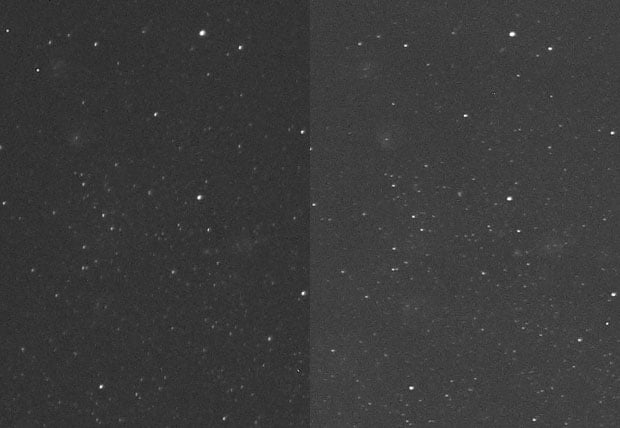How To Remove A Misthreaded Camera Filter
![]()
In October 2012, astrophotographer Raymond Collecutt of Whangarei, New Zealand shared a new (and risky) idea he was playing around with: converting a standard DSLR into a sharper monochrome photographic camera for photographing space.
After removing the glass layer that'south covering the sensor of his Canon 1000D ("It pops off slowly with a small screwdriver," he says), Collecutt started scratching the green layer from the surface of his sensor using a soft point. This layer is the colour filter array (CFA) that helps capture color information. It's a layer that's directly on the surface of the sensor (dissimilar the infrared filter, which sits above the sensor).
Here'southward a video showing the layers being scraped off:
Collecutt'south initial tests were crude but promising. He didn't remove the color filter layer to the edges of the frame, since there were important little wires at the sides. "I'thou going to take a better go at cleaning the sensor upward," the photographer wrote at the time:
![]()
Despite the rough removal job, resulting photographs captured using the modified sensor showed more than sensitivity in the monochrome areas:
![]()
![]()
![]()
His first tests with photographing the dark sky were besides promising:

Regarding the advantages of this dangerous hack, Collecutt offers a sunglass analogy, saying, "It'southward similar taking its sunglasses off. If you were to put [a filter] in front of a standard DSLR, but one out of 4 pixels would exist getting the light, but with the bayer filter removed all four pixels will be getting the same amount of low-cal."
In the months that have passed since Collecutt'southward initial tests, other photographers take continued tinkering with their own sensors and building upon Collecutt's thought. The original forum post is at present 25 pages long.
A photographer named Dave reported that scratching off the layer removes both the color filter layer and the microlens layer to a higher place it. Losing the microlenses reduces sensitivity, but removing the filter increases it. He says the optical improvement isn't very big, merely there are big gains to be had in IR and UV photography.
Dave likewise discovered that he could easily scrape off the filter layers using a scraping tool made from the plastic end of a paintbrush. This removes the filters without dissentious the sensor underneath.
February of this year is when photographer Luis Campos got in on the action. He discovered that he could remove the CFA layer by cracking the layer open with a small hypodermic needle, so scraping off the whole matter slowly using a carved wooden tip:
Campos writes that this DIY monochrome DSLR is "a great tool for the low upkeep amateur astronomer," and that the removal of the CFA more than makes up for the loss of the microlenses. He has been posting some cute astronomy photographs taken with his "Mono Catechism" to his Flickr account. You can find two of them hither and here.
![]()
![]()
If you'd rather non put your photographic camera at hazard with this crazy DIY hack, you can shell out some serious cash for a Leica M Monochrom, the new commercial camera that comes without the color filter array.
Want a more in-depth wait at how this hack is done and how it was adult? You can read through the 25 pages of "research" done and then far by the members of the Stargazers Lounge forum. It's interesting seeing how things take progressed from Collecutt's initial discovery to Campos' completed hack.
Image credits: Photographs by Raymond Collecutt and used with permission
Source: https://petapixel.com/2013/08/04/scratching-the-color-filter-array-layer-off-a-dslr-sensor-for-sharper-bw-photos/
Posted by: davingoetted84.blogspot.com

0 Response to "How To Remove A Misthreaded Camera Filter"
Post a Comment